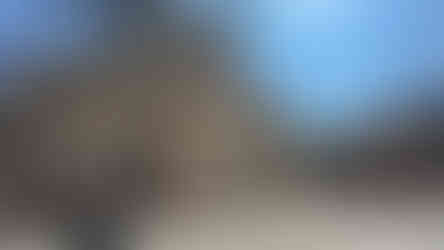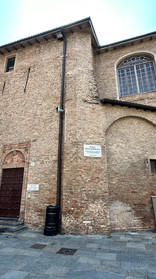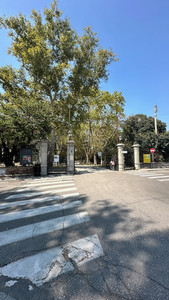Oltretorrente District - Quartiere Oltretorrente Parma
- Maria Scuor
- Oct 6, 2024
- 9 min read
Italiano sotto ogni sezione
Oltretorrente translates to “beyond the stream” which is exactly where this town is located taking a bridge from Parma over the Parma Torrente and walking into a town that dates back to 1210. With a population of about 8,500 and total surface area of 1.1 km squared, it is also called Parma Vecchia (Old Parma), even though it isn’t as old as Parma.
This district has had the most diverse inhabitants that in ancient times it was called Scozia (Scotland) or Svizzera (Switzerland) and today is the city district with the most foreign immigrants. During the twenty years of fascism, it was partly demolished and during the wars it was attacked. Despite the losses, the Oltretorrente still preserves some of the most evocative corners of Parma, characterized by simple but very picturesque houses.
We crossed the Mezzo (middle) Bridge which is one of the oldest in Parma and the original wooden bridge dates back to 1177 and was destroyed by a fury of water, but rebuilt in stone in 1547. The parapets were changed to stone in 1685 and has since been known as the “Stone bridge”. In 1723, a small chapel was placed mid-span, dedicated to St. John of Nepomuk however it was removed after the riots of June 1914. The bridge was renovated to its current state from 1932 to 1934.
Once across the bridge we walk into Piazza Filippo Corridoni which has a bronze statue of Filippo who was a revolutionary trade unionist that organized the strikes of the labourers. He was a friend of the future leader of fascism, Benito Mussolini whose ideology he followed. He is known for standing up in the trenches on October 23, 1915, shouting loudly with his arms raised, “Long Live Italy”.
It is assumed he died there shortly after because the Austrians counterattacked an many died. His body was never found. He was decorated with the silver medal of military honour however Mussolini converted it into a gold medal of military valour in 1925. Mussolini also approved the sketches of this statue and on October 23, 1925, ten years after his death, Mussolini placed the first stone for the building of the statue. The statue was inaugurated on October 30, 1927.
Here are photos of the bridge, Piazza Filippo Corridoni and some sights - Ecco le foto del ponte, di Piazza Filippo Corridoni e di alcuni luoghi d'interesse
Quartiere Oltretorrente Parma
Oltretorrente si traduce in "oltre il torrente", che è esattamente dove si trova questa città, prendendo un ponte da Parma sul Torrente Parma e camminando in una città che risale al 1210. Con una popolazione di circa 8.500 abitanti e una superficie totale di 1,1 km quadrati, è chiamata anche Parma Vecchia, anche se non è antica come Parma.
Questo quartiere ha avuto gli abitanti più diversi che anticamente si chiamava Scozia o Svizzera e oggi è il quartiere della città con il maggior numero di immigrati stranieri. Durante il ventennio fascista fu in parte demolita e durante le guerre fu attaccata. Nonostante le perdite, l'Oltretorrente conserva ancora alcuni degli angoli più suggestivi di Parma, caratterizzati da case semplici ma molto pittoresche.
Abbiamo attraversato il Ponte di Mezzo, uno dei più antichi di Parma, e il ponte di legno originale risale al 1177 e fu distrutto da una furia d'acqua, ma ricostruito in pietra nel 1547. I parapetti furono cambiati in pietra nel 1685 e da allora è stato conosciuto come il "ponte di pietra". Nel 1723 fu collocata una piccola cappella a metà campata, dedicata a San Giovanni Nepomuceno, ma fu rimossa dopo i tumulti del giugno 1914. Il ponte fu restaurato e riportato allo stato attuale dal 1932 al 1934.
Una volta attraversato il ponte entriamo in Piazza Filippo Corridoni dove si trova una statua bronzea di Filippo, che fu un sindacalista rivoluzionario che organizzò gli scioperi dei braccianti. Era amico del futuro leader del fascismo, Benito Mussolini di cui seguiva l'ideologia. È noto per essersi alzato in trincea il 23 ottobre 1915, gridando a gran voce con le braccia alzate: "Viva l'Italia".
Si presume che sia morto lì poco dopo perché gli austriaci hanno contrattaccato e molti sono morti. Il suo corpo non è mai stato trovato. Fu decorato con la medaglia d'argento all'onore militare, ma Mussolini la trasformò in una medaglia d'oro al valor militare nel 1925. Mussolini approvò anche i bozzetti di questa statua e il 23 ottobre 1925, dieci anni dopo la sua morte, pose la prima pietra per la costruzione della statua. La statua fu inaugurata il 30 ottobre 1927.
Church of the Most Holy Annunciation - Chiesa della Santissima Annunziata
The original convent church of the Santissima Annunziata also known as the Basilica of Paradise was built in 1211 however had to be demolished in 1546 due to the “tagliata” meaning the demolition and removal of all buildings and trees located around the city walls. This was decreed for defensive purposes by Duke Pier Luigi Farnese. One year later, Luigi was succeeded by his son Ottavio and he had to face opposition from the Emperor Charles V, Pope Julius III and the aristocracy of Parma. In 1552 Ottavio managed to have the duchy returned and to celebrate ordered the reconstruction of the convent and the church.
The church was founded on May 9, 1566 and the duke laid the first stone on June 4, 1567. The building has a central body with an elliptical plan with 5 apses on each side. There is a large entrance arch to access the building and a large stucco relief of an Annunciation Madonna is located above the tympanum of the central door that was built in 1681. There is a pipe organ that was built in 1805 and restored in 1991 located on the choir in the presbytery. The organ is of mechanical transmission, with a single keyboard and pedal board
The church was closed when we visited therefore, I don't have any interior photos.
Here are photos of the church - Ecco le foto della chiesa
Chiesa della Santissima Annunziata
L'originaria chiesa conventuale della Santissima Annunziata, nota anche come Basilica del Paradiso, fu costruita nel 1211 ma dovette essere demolita nel 1546 a causa della "tagliata", ovvero la demolizione e la rimozione di tutti gli edifici e gli alberi situati intorno alle mura della città. Questo fu decretato a scopo difensivo dal duca Pier Luigi Farnese. Un anno dopo, a Luigi successe il figlio Ottavio e dovette affrontare l'opposizione dell'imperatore Carlo V, di papa Giulio III e dell'aristocrazia parmense. Nel 1552 Ottavio riuscì a far rientrare il ducato e per festeggiare ordinò la ricostruzione del convento e della chiesa.
La chiesa fu fondata il 9 maggio 1566 e il duca pose la prima pietra il 4 giugno 1567. L'edificio presenta un corpo centrale a pianta ellittica con 5 absidi per lato. C'è un grande arco d'ingresso per accedere all'edificio e un grande rilievo in stucco di una Madonna dell'Annunciazione si trova sopra il timpano della porta centrale che fu costruita nel 1681. C'è un organo a canne che è stato costruito nel 1805 e restaurato nel 1991 situato sul coro nel presbiterio. L'organo è a trasmissione meccanica, con un'unica tastiera e pedaliera
La chiesa era chiusa quando l'abbiamo visitata, quindi non ho foto degli interni.
Ducale Park and Palace - Parco e Palazzo Ducale
In 1561, Duke Ottavio Farnese started to build his palace along with the park located in Oltretorrente district. The park also known as “the garden” is large at 208,700 metres squared.
The old 14th century castle and buildings were demolished to make room for the Duke’s palace and park.
The palace was built in baroque and neoclassical styles which was typical of what the Farnese family was building in other regions. A grandiose fountain, with numerous statues and water features was placed in front of the palace. The interior included rooms fully decorated with artwork from very prominent artists of the times. By the 17th century the palace was modified and enlarged.
After the unification of Italy, the palace hosted the Infantry and Calvary Application School. The palace was heavily damaged by the events of the Second World War and it wasn’t until 1953 that it became the headquarters of the Command of the Legion of the Carabinieri of Parma and continues to be. Reconstructions began in 1959 and lasted until 1968, with more renovations done in 2004 and in subsequent years.
There are many works of art in the palace as well as a monumental 18th century staircase which leads to the large hall on the first floor, called the Hall of Birds, because 224 bird species are represented on the ceiling with stucco and fresco decorations.
The first garden consisted of a central avenue aligned with the facade of the new palace and had symmetrical flowerbeds flanked with fountains. It had an orchard with all types of fruit trees as well as many other trees.
In 1690, Duke Ranuccio II Farnese commissioned a large ovoid fish pond to be built to celebrate his son’s Odoardo wedding. The pond had an islet in the middle to stage nautical shows called naumachie. The guests invited to the wedding watched an opera that was performed on that stage.
By 1731 the park fell into a state of decline after the extinction of the Farnese family. Wars further impacted the park as the trees were used to feed the fires of the troops. In 1749 Duke Philip of Bourbon ordered a complete restructuring of the park by a French architect and the neoclassical park was born. Napoleon visited the park on June 27, 1805 which the municipality of Parma organized an arts and craft fair in his honour.
After the unification of Italy, the walls came down and the park was open to the public. However, by 1920 the park needed a lot of work and it was reorganized the scenographer, Giuseppe Carmignani. Between 2000 and 2001 the park was completely renovated, returning it to its neoclassical appearance, based on Petitot's designs.
Over the years many statues and buildings have been added to the park to give it, its amazing character. A theatre exists in the park now, but originally was built between 1939 and 1941 as a venue for trade fairs. In 1987, the municipality decided to use the unused building as a public theatre. The theater has two halls; the main one hosts a stepped stalls with a capacity of 400 seats, while the smaller one has a mobile staircase that can accommodate 150 people. The events have been managed by Solares Fondazione delle Arti since 2007.
This park with gardens, fountains, a temple, statues, theatre, ponds and a palace is truly beautiful and a great way to spend a few hours walking and enjoying the peace and serenity.
Here are photos of the park and palace Ducale - Ecco le foto del parco e del palazzo Ducale
Parco e Palazzo Ducale
Nel 1561 il duca Ottavio Farnese iniziò a costruire il suo palazzo e il parco situato in contrada Oltretorrente. Il parco, noto anche come "il giardino", è grande con i suoi 208.700 metri quadrati.
Il vecchio castello e gli edifici del XIV secolo furono demoliti per fare spazio al palazzo del Duca e al parco.
Il palazzo fu costruito in stile barocco e neoclassico, tipico di ciò che la famiglia Farnese stava costruendo in altre regioni. Di fronte al palazzo era collocata una grandiosa fontana, con numerose statue e giochi d'acqua. L'interno comprendeva stanze completamente decorate con opere d'arte di artisti molto importanti dell'epoca. Nel XVII secolo il palazzo fu modificato e ampliato.
Dopo l'Unità d'Italia, il palazzo ospitò la Scuola di Fanteria e Calvario. Il palazzo fu pesantemente danneggiato dagli eventi della Seconda Guerra Mondiale e fu solo nel 1953 che divenne la sede del Comando della Legione dei Carabinieri di Parma e continua ad esserlo. Le ricostruzioni iniziarono nel 1959 e durarono fino al 1968, con ulteriori ristrutturazioni fatte nel 2004 e negli anni successivi.
Numerose sono le opere d'arte presenti nel palazzo oltre ad una monumentale scalinata settecentesca che conduce al grande salone del primo piano, chiamato Sala degli Uccelli, perché sul soffitto sono rappresentate 224 specie di uccelli con decorazioni a stucco e affreschi.
Il primo giardino era costituito da un viale centrale allineato con la facciata del nuovo palazzo e presentava aiuole simmetriche fiancheggiate da fontane. Aveva un frutteto con tutti i tipi di alberi da frutto e molti altri alberi.
Nel 1690 il duca Ranuccio II Farnese fece costruire una grande peschiera ovoidale per celebrare le nozze del figlio Odoardo. Lo stagno aveva un isolotto al centro per mettere in scena spettacoli nautici chiamati naumachie. Gli invitati al matrimonio hanno assistito a un'opera lirica che è stata rappresentata su quel palco.
Nel 1731 il parco cadde in uno stato di degrado dopo l'estinzione della famiglia Farnese. Le guerre hanno avuto un ulteriore impatto sul parco poiché gli alberi sono stati utilizzati per alimentare i fuochi delle truppe. Nel 1749 il duca Filippo di Borbone ordinò una completa ristrutturazione del parco da parte di un architetto francese e nacque il parco neoclassico. Napoleone visitò il parco il 27 giugno 1805 e il comune di Parma organizzò una fiera delle arti e dei mestieri in suo onore.
Dopo l'Unità d'Italia, le mura caddero e il parco fu aperto al pubblico. Tuttavia, nel 1920 il parco aveva bisogno di molti lavori e fu riorganizzato lo scenografo, Giuseppe Carmignani. Tra il 2000 e il 2001 il parco è stato completamente rinnovato, riportandolo al suo aspetto neoclassico, su progetto di Petitot.
Nel corso degli anni molte statue ed edifici sono stati aggiunti al parco per dargli il suo carattere sorprendente. Nel parco esiste ora un teatro, ma originariamente fu costruito tra il 1939 e il 1941 come sede di fiere. Nel 1987 il comune decise di adibire l'edificio inutilizzato a teatro pubblico. Il teatro ha due sale; La principale ospita una platea a gradoni con una capienza di 400 posti a sedere, mentre quella più piccola ha una scala mobile che può ospitare 150 persone. Gli eventi sono gestiti da Solares Fondazione delle Arti dal 2007.
Questo parco con giardini, fontane, un tempio, statue, teatro, stagni e un palazzo è davvero bellissimo e un ottimo modo per trascorrere qualche ora passeggiando e godendo della pace e della serenità.







































































Comments